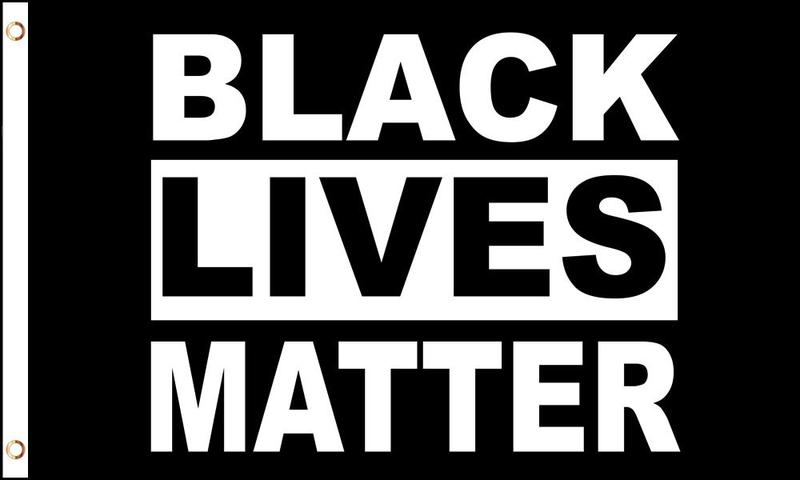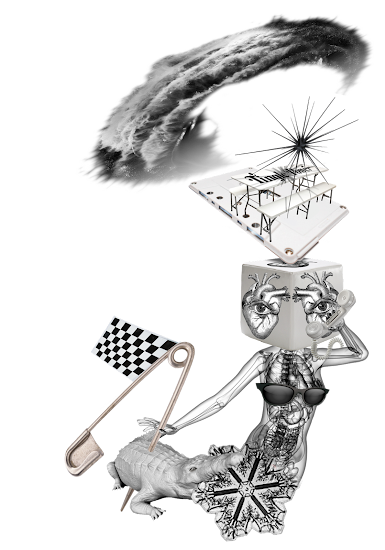This 2018 essay was updated/revised in 2020.
Last weekend, as we drove thru the countryside of my state, my wife pointed to a pickup truck flying two large flags and asked if I knew what the black and white one represented. Although I'd never seen an "American flag" with: black bars instead of red, a black field behind the stars instead of blue, and a horizontal blue bar thru the middle — I was able to make a reasonably informed guess (because the other flag in the back of the pickup was a confederate battle flag).
 There are a few variations of banners with these blue lines. Even though they range from those with solid black backgrounds, or combined with the stars and bars, or the union jack (as well as with the aforementioned stars and stripes), I've discovered one strong common denominator: all appear to have been created in the last five years — after 2013 — when the Black Lives Matter (BLM) movement began.
There are a few variations of banners with these blue lines. Even though they range from those with solid black backgrounds, or combined with the stars and bars, or the union jack (as well as with the aforementioned stars and stripes), I've discovered one strong common denominator: all appear to have been created in the last five years — after 2013 — when the Black Lives Matter (BLM) movement began.
 For many decades, the descriptor: 'thin blue line' has been used as a simile. By referring to the police force as the "front line" of law enforcement, the phrase successfully brings to mind a line of blue-uniformed officers fighting valiantly to separate and protect law abiding citizens from criminals. I joined the Military Police in 1985, but it wasn't until 1990 — with the film The Thin Blue Line — that I learned this term was a label for police.
For many decades, the descriptor: 'thin blue line' has been used as a simile. By referring to the police force as the "front line" of law enforcement, the phrase successfully brings to mind a line of blue-uniformed officers fighting valiantly to separate and protect law abiding citizens from criminals. I joined the Military Police in 1985, but it wasn't until 1990 — with the film The Thin Blue Line — that I learned this term was a label for police.
 If someone wants to show police solidarity and also wants to display their support in the form of a banner (on the back of their Ford F150—as an example) they should consider a emblem from the Fraternal Order of Police (FOP). This organization is over a century old, advocates for the safety of law enforcement officers, and the FOP logo contains no words intended to usurp the message of another group.
If someone wants to show police solidarity and also wants to display their support in the form of a banner (on the back of their Ford F150—as an example) they should consider a emblem from the Fraternal Order of Police (FOP). This organization is over a century old, advocates for the safety of law enforcement officers, and the FOP logo contains no words intended to usurp the message of another group.
The number of flags, banners, and signs which bring universal scorn to those who display them publicly is growing. Included in this list are the signs of the "Church" from Westboro, Kansas; the flag of the National Socialist German Workers' Party (the Nazi Swastika); and some variants of the US Confederate Battle Flag (Confederate Southern Cross). Specious claims of "pride in one's heritage" are no longer palatable by the masses. Since there are still many who want to publicly display their hatred for others, the white supremacists have recently adopted the thin blue line flag, which provides a superficially plausible explanation (claiming to support the police) while actually displaying their hate-filled message (which is that black lives don't matter to them).


are the same as
Last weekend, as we drove thru the countryside of my state, my wife pointed to a pickup truck flying two large flags and asked if I knew what the black and white one represented. Although I'd never seen an "American flag" with: black bars instead of red, a black field behind the stars instead of blue, and a horizontal blue bar thru the middle — I was able to make a reasonably informed guess (because the other flag in the back of the pickup was a confederate battle flag).
 There are a few variations of banners with these blue lines. Even though they range from those with solid black backgrounds, or combined with the stars and bars, or the union jack (as well as with the aforementioned stars and stripes), I've discovered one strong common denominator: all appear to have been created in the last five years — after 2013 — when the Black Lives Matter (BLM) movement began.
There are a few variations of banners with these blue lines. Even though they range from those with solid black backgrounds, or combined with the stars and bars, or the union jack (as well as with the aforementioned stars and stripes), I've discovered one strong common denominator: all appear to have been created in the last five years — after 2013 — when the Black Lives Matter (BLM) movement began. If someone wants to show police solidarity and also wants to display their support in the form of a banner (on the back of their Ford F150—as an example) they should consider a emblem from the Fraternal Order of Police (FOP). This organization is over a century old, advocates for the safety of law enforcement officers, and the FOP logo contains no words intended to usurp the message of another group.
If someone wants to show police solidarity and also wants to display their support in the form of a banner (on the back of their Ford F150—as an example) they should consider a emblem from the Fraternal Order of Police (FOP). This organization is over a century old, advocates for the safety of law enforcement officers, and the FOP logo contains no words intended to usurp the message of another group. The number of flags, banners, and signs which bring universal scorn to those who display them publicly is growing. Included in this list are the signs of the "Church" from Westboro, Kansas; the flag of the National Socialist German Workers' Party (the Nazi Swastika); and some variants of the US Confederate Battle Flag (Confederate Southern Cross). Specious claims of "pride in one's heritage" are no longer palatable by the masses. Since there are still many who want to publicly display their hatred for others, the white supremacists have recently adopted the thin blue line flag, which provides a superficially plausible explanation (claiming to support the police) while actually displaying their hate-filled message (which is that black lives don't matter to them).
- The Thin Blue Line Flag is equivalent to the Blue Lives Matter banner.
- "Blue Lives Matter" has one purpose: opposing the "Black Lives Matter" message.
- "Black Lives Matter" opposes violence and racism against people of color by the police.


are the same as
updated/revised: June 2020








































10 comments:
your a fucking dumb ass it doesnt mean anything besides support for the police
Zakery is obviously someone who is either incapable of understanding logical reasoning, dislikes that the banner he thought meant one thing actually means something else, or already knew and just doesn't want the "secret" to get out. Which is it?
Rare to observe Dunning Kruger in such a short space.
It only took him 14 words - your a fucking dumb ass it doesnt mean anything besides support for the police - to proclaim that he is an ignorant racist with no critical thinking abilities.
You should at least give him credit for his succinctness!
Yay for succinct stupidity, I guess.
OMFG your totally making up this stupid shit. Im a police officer and we wear the blueline flag on our uniform sholder and that wouldnt be allowed if it was racist, would it
Whomever decided to put the blue-line flag on OMFG's uniform either was as unaware as he is that it holds a dual meaning (support the police & black lives don't matter) - or - they were fully aware.
Which is more logical: that a law enforcement agency would be self-aggrandizing and put this emblem on their uniforms to tell others they "support themselves" - or - they don't support the BLM movement?
Hey OMFG! Are you in a 100% white police force in some rural southern state?
You're
just trying to tell people with stupid pictures and try to make people think that it is what it stands for your one of those people that starts rumors and lies like the democrats for a great example.
Thank you. Your failed spelling, punctuation, and grammar--as well as stereotyping me (as a democrat *gasp*)--makes my point for me: hate and ignorance go hand in hand.
I decided to paste your comment here (just in case troll-skin is thin):
You're
just trying to tell people with stupid pictures and try to make people think that it is what it stands for your one of those people that starts rumors and lies like the democrats for a great example.
This is all fine and dandy except you failed to point out that the thin blue line was around for over 6 decades before black lives matter. Congratulations, you played yourself.
Proving the 'blue lives matter' movement/banner existed before the Black Lives Matter movement would do nothing to disprove that, today (middle of 2020), those who display the blue lives matter banner or say the words "blue/all lives matter" are either saying they fully support and condone violence against people of color. . .or they are fools who've done no research.
Usage of the phrase 'the thin blue line' is not at issue (it can be found in a centuries-old poem). However, the banner(s) and flag(s) with blue lines thru them were all created after 2013, by people who are against the Black Lives Matter movement and, therefore, support violence against people of color.
I have never found a photograph of a blue lives matter flag/banner which might be accurately dated to decades ago (I've looked). But if one does exist, it wouldn't change that it has been appropriated by white supremacist group(s). Everyone who displays it, today, displayed the confederate battle cross or the Nazi swastika decades ago.
Post a Comment